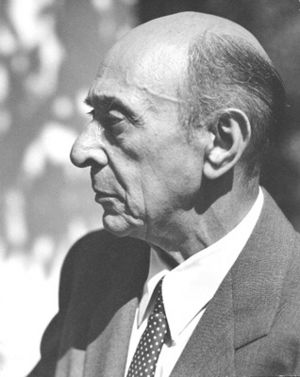Expressionist music facts for kids
Expressionist music is a style of music that started in the early 1900s. It's all about showing strong, deep feelings and emotions, even if they are dark or uncomfortable. Think of it like a painter who uses bold colors and distorted shapes to show what they feel inside, rather than just painting a pretty picture.
This type of music often sounds very different from traditional music. It uses lots of clashing notes (called dissonance). It also has sudden changes in how loud or soft it is, and melodies that might sound "bent" or "broken." Composers wanted to express their inner thoughts and feelings without following old rules about how music should sound. They wanted to be completely honest about human emotions, even fear or sadness.
Contents
Who Were the Main Composers?
The most important people in musical expressionism were Arnold Schoenberg (1874–1951) and his students, Anton Webern (1883–1945) and Alban Berg (1885–1935). They are often called the Second Viennese School.
Other composers who also wrote expressionist music include Ernst Krenek, Paul Hindemith, Igor Stravinsky, and Alexander Scriabin. Béla Bartók also wrote some early works that fit this style, like his opera Bluebeard's Castle (1911). Some American composers like Carl Ruggles and Charles Ives also showed similar ideas in their music.
Even older composers like Richard Wagner, Gustav Mahler, and Richard Strauss helped set the stage for expressionism. Later composers, such as Peter Maxwell Davies, have also been inspired by this intense style.
Arnold Schoenberg's Role
Musical expressionism is very connected to the music Arnold Schoenberg wrote between 1908 and 1921. During this time, he wrote music that was "free atonal." This means it didn't use a main key or home note, which is very different from most music you hear. Later, he developed a new system called the twelve-tone technique.
Schoenberg's Second String Quartet (written 1907–08) is a good example of his move into expressionism. In this piece, the music slowly loses its traditional key. In the last part, a singer sings, "I feel the air of another planet." This line suggests Schoenberg was entering a new, different world of music without a clear key.
Expressing Deep Feelings in Music
In 1909, Schoenberg wrote a short opera called Erwartung (Expectation). It's about a woman who is looking for her lover in a dark forest. She finds him dead, and the whole story is told from her very emotional point of view. The music shows all her fear and sadness. The writer of the story, Marie Pappenheim, knew about new ideas in psychology at the time, which helped Schoenberg explore deep feelings in the music.
Schoenberg also wrote Five Pieces for Orchestra in 1909. He tried to create these pieces freely, letting his deep, unconscious feelings guide him. He wanted the music to avoid any clear, traditional forms.
Another work by Schoenberg is the musical play Die glückliche Hand (The Lucky Hand). The music here is also atonal. The story is very symbolic. It's about a man who is sad because his wife left him. He tries to prove himself by creating a masterpiece. This story was written by Schoenberg himself. It showed his own struggles and how he felt about people not liking his new music. He wanted to create something great, just like the man in the story.
Schoenberg and Kandinsky
Around 1911, Schoenberg became good friends with the painter Wassily Kandinsky. They both believed that art should show what's inside a person, their deep feelings, without being held back by rules. They exchanged their artworks and wrote for each other's publications. This friendship was very important for musical expressionism. Schoenberg even started painting himself, and his paintings, like "Red Gaze," often showed intense emotions through colors and eyes.
Anton Webern and Alban Berg
Anton Webern was one of Schoenberg's students. His music was also very expressionist around 1909–1913. His Five Pieces for Orchestra, Op. 10, are from this time. Even when his music later became more structured, it still had a strong emotional core hidden within it.
Alban Berg was another important student of Schoenberg. His most famous expressionist works are his operas, Wozzeck (finished in 1925) and the unfinished Lulu.
Wozzeck is a very expressionist opera because it shows a lot of mental pain and suffering. The story is mostly seen through the eyes of the main character, Wozzeck. Even though it's very emotional, Berg used clever musical forms to organize it. For example, he used traditional forms like sonata form in some scenes. This made the story easier to understand, but it was a bit different from Schoenberg's idea of completely free expression.
Berg worked on Lulu from 1928 to 1935. This opera is also very complex and uses expressionist ideas. However, some people think Lulu is closer to a different style called Neue Sachlichkeit (New Objectivity). This style was more about showing things clearly and without too much emotion, which was different from pure expressionism.
By the time Wozzeck was performed in 1925, Schoenberg had already moved on. He started teaching his students his new twelve-tone technique around 1923. This marked the end of his main expressionist period.
So, while Arnold Schoenberg was the most central figure in musical expressionism, Berg, Webern, and Bartók also made important contributions, along with many other composers.
See also
 In Spanish: Expresionismo musical para niños
In Spanish: Expresionismo musical para niños


